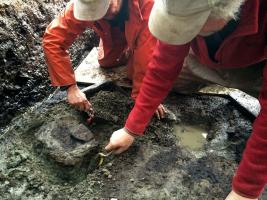
Photo : Grant Callegari/Hakai Institute
The remarkable discovery of 29 ancient footprints just above what would have been the tide line on Calvert Island in British Columbia provides new evidence to support the idea that early humans first migrated to America by sea along what is termed the termed the “kelp highway.” The discovery also confirms the stories told by the Heiltsuk and Wuikinuxv peoples of British Columbia of when their ancestors fished and foraged along a thin green strip of coastline between open ocean and impenetrable inland ice.
For many decades, the assumption was that early travelers to America walked across a Siberian landbridge around 13,000 years ago. The problem is that new research suggests that a terrestrial route across the landbridge was blocked by ice until around 10,000 years ago. Perhaps early travelers came by sea rather than by land. Currently, archeologists are suggesting that early mariners traveled by boat from Asia to America, following the coastline and the retreating ice sheets on what is being referred to as the “kelp highway.”
The footprints were discovered by a team lead by Duncan McLaren, an anthropologist at the Hakai Institute and University of Victoria buried in the shoreline of Calvert Island, part of the First Nations’ traditional territory. The prints represent at least three people — perhaps two adults and a child — and they date back more than 13,000 years, to the end of the last ice age.
“As this island would only have been accessible by watercraft 13,000 years ago,” Dr. McLaren said to the New York Times, “it implies that the people who left the footprints were seafarers who used boats to get around, gather and hunt for food and live and explore the islands.” Archaeologists say the footprints are the oldest in North America — proof that humans were here at the end of the Pleistocene.
The Washington Post reports: To the Heiltsuk and the Wuikinuxv, members of First Nations who call this land home, the prints are an affirmation of a tradition that goes back to time immemorial.
“Just to know that it’s a place that our ancestors previously walked and now here we still are today, it’s really powerful for us,” William Housty, a member of the Heiltsuk Nation, told the Washington Post.
“It’s really, really exciting but also very emotional,” said Housty, a member of the board of directors for the Heiltsuk Integrated Resource Management Department, which authorizes and oversees projects such as the one at Calvert Island. “You hear the history and the stories, and now you’re standing and looking at something that’s real, that’s confirming the stories that have been handed down over the generations.”
